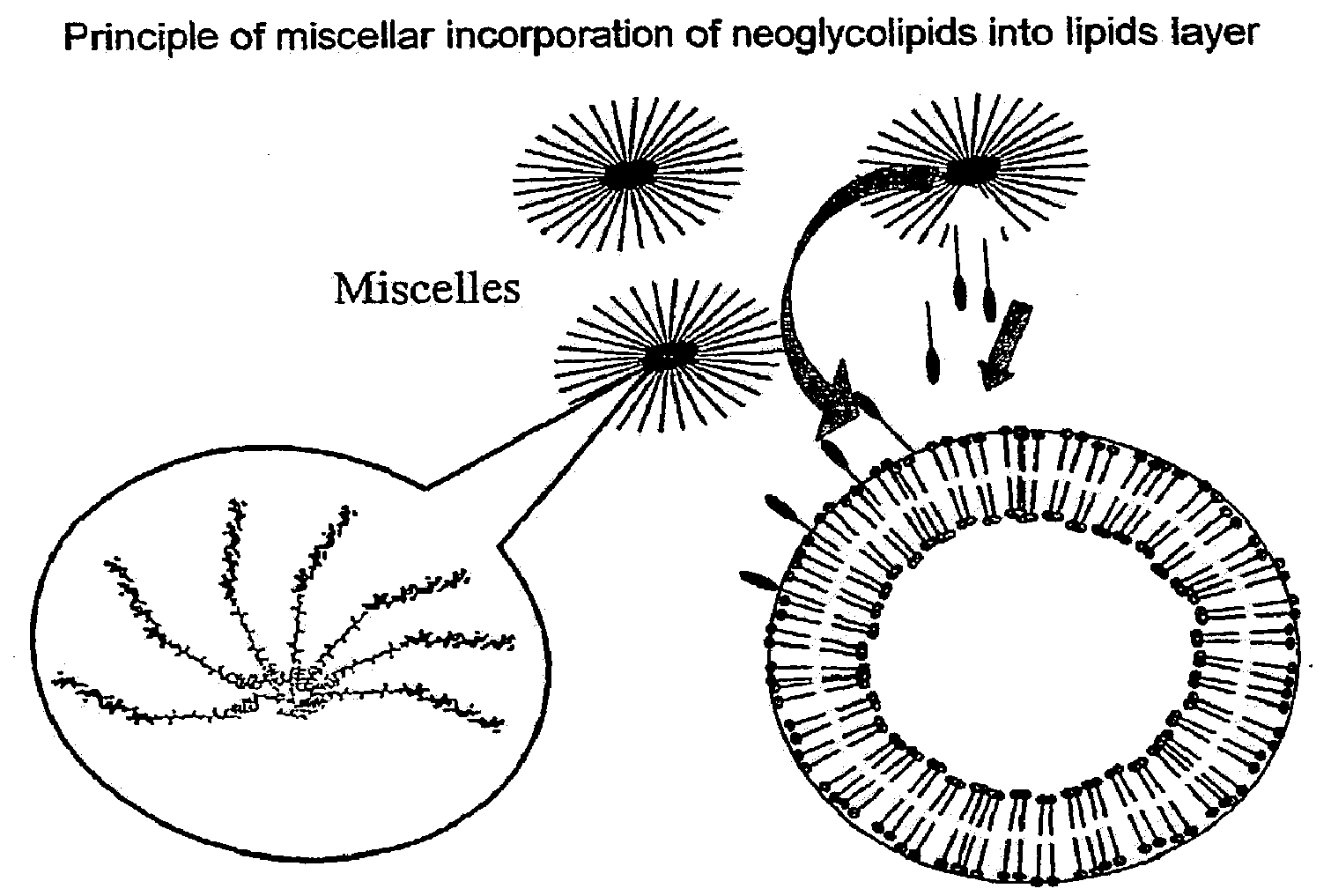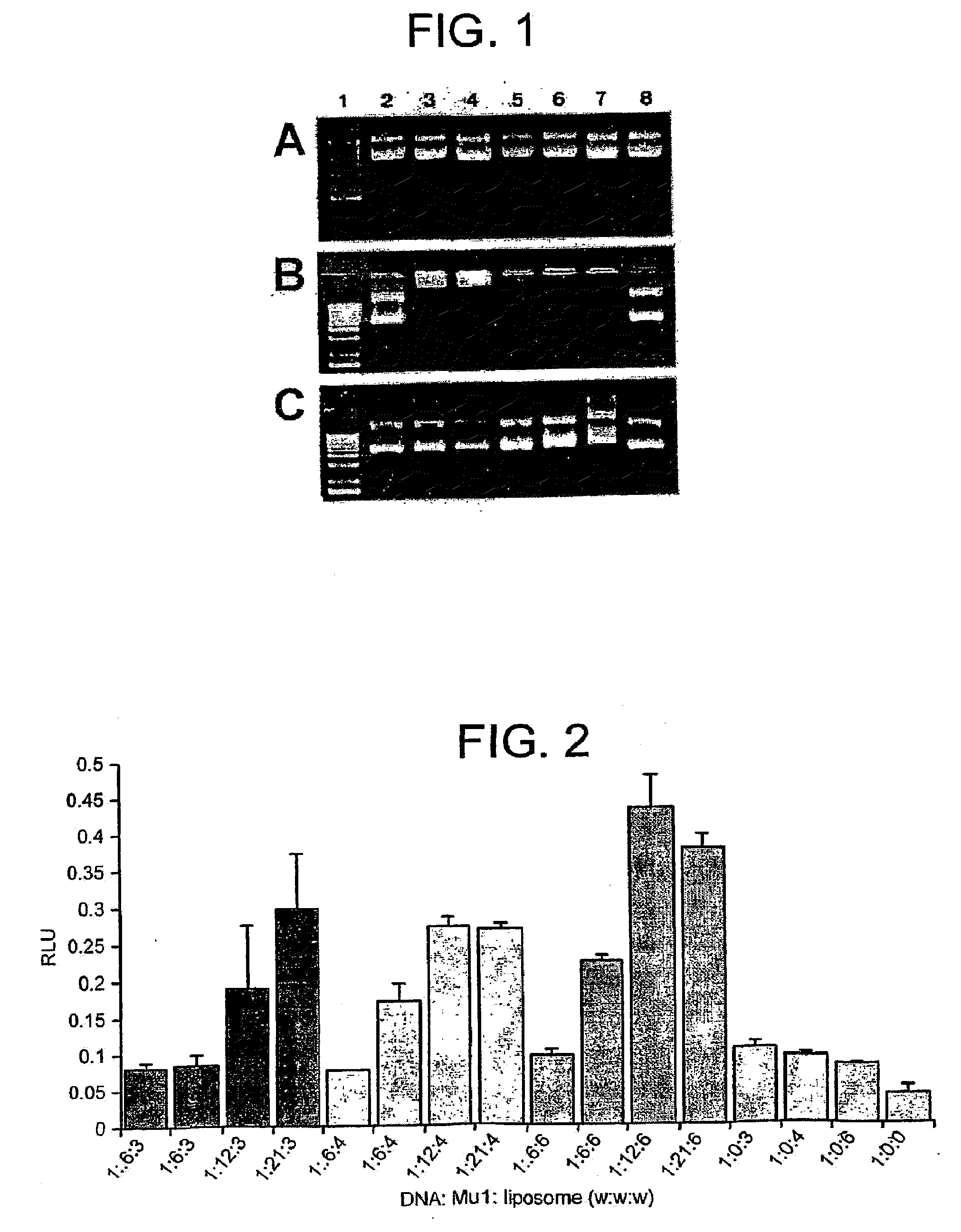Viral core protein-cationic lipid-nucleic acid-delivery complexes
a cationic lipid and core protein technology, applied in the direction of peptide/protein ingredients, dsdna viruses, peptide sources, etc., can solve the problems non-viral mediated gene transfer is the formation of large aggregated molecules, and the cns gene therapy is hampered, etc., to improve the cationic liposome mediated gene transfer, improve the effect of liposome based gene transfer and mu1 enhancemen
- Summary
- Abstract
- Description
- Claims
- Application Information
AI Technical Summary
Benefits of technology
Problems solved by technology
Method used
Image
Examples
example 1
DNA Binding Analysis
[0156]Mu1 is a polycationic peptide comprised of 19 amino acids associated with the core complex of Adenovirus (Table 1)27, 32. We compared the DNA binding capacity of Mu1 with the mouse polyomavirus major capsid protein Vp1 by interaction with plasmid DNA in a gel retardation assay. Vp1 is a 19 amino acid peptide that contains a nuclear localization signal26 and contains fewer positively charged amino acids than Mu1. It was therefore predicted to have a lower DNA binding capacity.
TABLE 1Mul and VP1 protein sequencesPoly-Charge / AApeptideSequenceMWratioMu1NH2-Met-Arg-Arg-Ala-His-His-Arg-Arg-Arg-24400.63Arg-Ala-Ser-His-Arg-Arg-Met-Arg-Gly-Gly-OHVP1NH2-Met-Ala-Pro-Lys-Arg-Lys-Ser-Gly-Val-Ser-Lys-20490.26Cys-Glu-Thr-Lys-Cys-Thr-Pro-Pro-OHThe NLS sequence in VP1 is underlined
[0157]Varying amounts of purified peptide were incubated at room temperature in HBS for approximately 10 minutes and then analyzed by agarose gel electrophoresis. Without the addition of peptide, ...
example 2
Transfection in Undifferentiated ND7s
[0159]We examined the ability of Mu1 and Vp1 to enhance the transfection of a neuronal cell line by cationic liposomes using a β-Galactosidase reporter gene assay. ND7 cells were transfected with pCMVβ complexed to varying amounts of peptide and DC-Chol / DOPE. We have previously shown that the cationic liposome DC-Chol / DOPE is capable of efficiently transfecting the neuronally derived ND7 cell line31. In this study we found that optimal efficiencies (>40%) were obtained in this neuronally derived cell line using 1 μg plasmid DNA complexed with 3 μg DC-Chol / DOPE31. Temporally, maximal levels of transgene expression are obtained between 48-60 hours post transfection. Therefore, in order to maximize the chance of detecting improvements in transfection we performed all our assays within 12-20 hours of transfection at a time when levels of reporter gene expression were lower. Previously we found a pDNA:liposome ratio of 1:3 (w / w) optimal for transfecti...
example 3
Transfection in Differentiated ND7s
[0163]We also examined the ability of Mu1 to improved cationic liposome-mediated transfection in differentiated ND7s. The ND7 cell line is derived from a fusion of primary rat dorsal root ganglia (DRG) neurons and the mouse neuroblastoma N18Tg228. ND7 cells can be differentiated in a variety of manners including the withdrawal of serum, cAMP administration or exposure to reduced serum plus cAMP and nerve growth factor. Differentiation of ND7s leads to the expression of cellular properties associated with their parental nociceptive sensory neurons including a reduction in cell division and the onset of neurite outgrowth. ND7 cells were seeded in 24 well culture plates and 24 hours later differentiated. Fifteen to 20 hours following the onset of differentiation, they were transfected as above. Fifteen to 20 hours following transfection, cells were fixed and processed for X-gal histochemistry. Consistent with previous observations, transfection effici...
PUM
| Property | Measurement | Unit |
|---|---|---|
| molecular weights | aaaaa | aaaaa |
| molecular weights | aaaaa | aaaaa |
| size | aaaaa | aaaaa |
Abstract
Description
Claims
Application Information
 Login to View More
Login to View More - R&D
- Intellectual Property
- Life Sciences
- Materials
- Tech Scout
- Unparalleled Data Quality
- Higher Quality Content
- 60% Fewer Hallucinations
Browse by: Latest US Patents, China's latest patents, Technical Efficacy Thesaurus, Application Domain, Technology Topic, Popular Technical Reports.
© 2025 PatSnap. All rights reserved.Legal|Privacy policy|Modern Slavery Act Transparency Statement|Sitemap|About US| Contact US: help@patsnap.com



